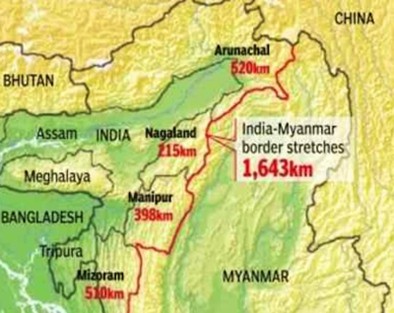Context & Background
- Free Movement Regime (FMR) History & Changes:
- Introduced in 1968 due to ethnic and familial ties.
- Territoriallimit changes:
- 40 km initially → reduced to 16 km (2004) → 10 km (2024).
- Additional regulations enforced in 2016 to strengthen security.
Relevance : GS 2(Governance ,International Relations)

- Operational Border Gates:
- 22 out of 43 crossing points under the revised FMR agreement are functional.
- Distribution of operational gates:
- Manipur: 10 gates
- Mizoram: 5 gates
- Nagaland: 5 gates
- Arunachal Pradesh: 2 gates
- Regulation and Security Measures:
- Assam Rifles designated as the primary agency for issuing border passes and conducting first-level security checks.
- State police forces (Arunachal Pradesh, Nagaland, Mizoram, Manipur) responsible for verification at the place of stay.
- QR code-enabled passes introduced for movement regulation.
- Biometric data recording and central database verification for security screening.
- Political & Security Implications:
- Despite Home Minister’s announcement on scrapping FMR, no formal orders from MEA yet.
- Myanmar faces intensified conflict between Ethnic Armed Organizations (EAOs) and the military junta since coup on Feb 1, 2021.
- Over 40,000 Chin refugees have entered Mizoram and Manipur since the coup.
Significance & Impact
- Humanitarian Aspect:
- Facilitates movement for border communities with deep cross-border ties.
- Ensures controlled access while addressing refugee concerns.
- Security Concerns:
- Increased surveillance amid conflict spillover risks.
- Potential challenges in tracking illegal migration and insurgency threats.
- Diplomatic Angle:
- India’s balancing act in managing border security without disrupting relations with Myanmar’s ethnic groups.
- Unclear future of FMR suspension, given lack of formal MEA directive.




